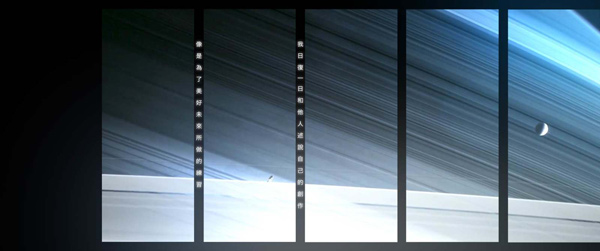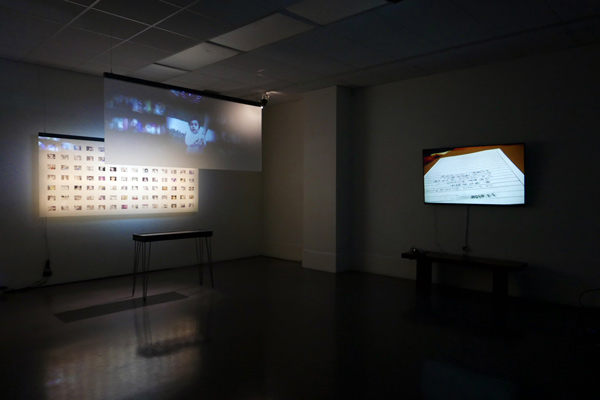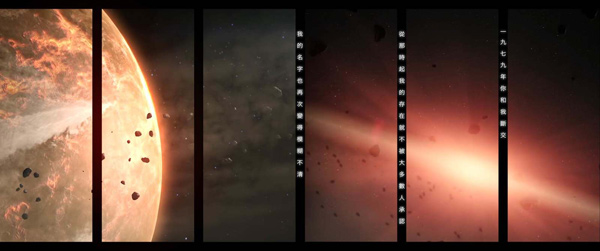Poyen Wang and Kio Griffith’s captivating exhibition “Atlas Portal” deftly explores cultural identity, the immigrant experience, and alienation through the lens of personal memory.

Poyen Wang, Crossing, Two-Channel Animated Video Installation 2018, 12 min., Loop, Color, Silent. Photo by Poyen Wang. Courtesy of Poyen Wang.
Wang is a digital media artist from Taiwan, and based in New York City since 2015. Griffith is a Los Angeles-based artist, curator, writer and producer, born to a Japanese mother and American father in Japan where he grew up. With Asian roots and immigrant experience, their thematic installations run parallel, but also diverge dramatically: While Wang examines his new home, Griffith examines who he is.

Poyen Wang, Six Excerpts from a Journal, Single Channel Animated Video, 2018, 11’ 25”, Loop, Color, Sound. Sound by Yen-Ting Hsu. Photo by Poyen Wang. Courtesy of Poyen Wang.
Among the five installations, highlights include Wang’s mixed-media “Route of Obsession Series,” a documentary of his experience following strangers in the New York City subways. Creative stalking perhaps, the process was a way to connect him, as a recent immigrant, to the city and its people. Each “performance,” took about three hours as he tagged behind seven to nine people while documenting their race, approximate age, and appearance. The journeys led him to create not only maps of the strangers’ routes, but also a method for examining our dependence on advancing technology, such as Google maps.

(Left) Poyen Wang, A Fabricated Personal Archive, Mixed-media Installation, Single Channel Animated Video Projection, Acrylic sheets, LED lights, Transparent films, Customized vitrine, 3D printed objects, 2017, 78” x 96” x 80”. Photo by Poyen Wang. Courtesy of Poyen Wang.
(Right) Kio Griffith, Proof of Person (Birth)人間の証明, Single Channel Video, 2018, 14’ 44”, Dimension Variable. Photo by Poyen Wang. Courtesy of Poyen Wang.
Wang also hones in on identity with “A Fabricated Personal Archive,” spotlighing how easily identity can be manipulated and altered through digital media. The idea for the work emerged after he discovered old film footage of American families that had been converted to video and posted on YouTube. He screen grabbed images of the children (all Caucasian) and inserted photos of his own face at about the same age, transforming the anonymous American kids into himself—Asian and Taiwanese. The installation offers a sweet and bizarre look at our unsettling relationship with digital archiving, while also touching on identity politics.

Kio Griffith, Proof of Person (Birth)人間の証明, Single Channel Video, 2018, 14’ 44”, Dimension Variable. Photo by Kio Griffith. Courtesy of Kio Griffith.
Kio Griffith’s singular work “Proof of Person (Birth)人間の証明” highlights his struggle to establish his legal identity in Japan after his birth certificate was lost during demolition of the hospital where he was born. As the child of a foreigner, his undocumented status is further complicated. In the narrative video, he is seen replicating his lost birth certificate in pencil, while his mother guides him by phone. Like Wang, he addresses cultural identity, but here the work appears more an affirmation of identity itself, and an assertion that recognizing one’s totality is important—and now possible in our borderless, digital world.
Poyen Wang, Kio Griffith, “Atlas Portal,” October 12, 2018 – January 12, 2019, at Taiwan Academy in Los Angeles, 1137 Westwood Blvd., Los Angeles, California 90024. https://www.facebook.com/taiwanacademyla











0 Comments